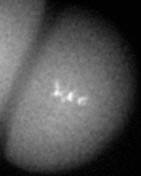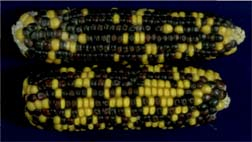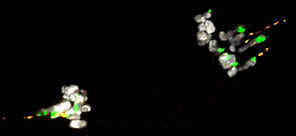Neocentromeres & Meiotic Drive

Neocentromeres leading the chromosomes at anaphase II.
Maize has a complex genome with many selfish elements such as transposons that take advantage of it. Perhaps the most visible of the selfish DNAs are found in big “knobs” that are present on nearly every chromosome arm (at 34 places, some lines have them, some don’t). We now know that each of these knobs owes their existence to the presence of a fascinating meiotic drive system on the end of chromosome 10 (called Ab10).
Ab10 is a variant of the normal chromosome 10 that has about ~30 cM of non-recombining sequence and some particularly huge knobs. The Ab10 haplotype also contains at least two genes that transform the knobs into centromere-like structures that move chromosome arms rapidly poleward at meiosis (see movie at left). This movement changes Mendelian segregation in favor of the knobs, so that the Ab10 haplotype and all the other knobs are transmitted to progeny at higher frequencies than expected (see image at right). This in turn causes the accumulation of the knobs and ensures the survival of Ab10, despite the fact that Ab10 has no other selective advantage.

Testcrosses showing preferential segregation of Ab10 (top) and the 1:1 ratio typical of normal chromosome 10 (bottom).
Knobs are made up of two different types of tandemly repeated sequences, one that is 180 bp and another that is 350 bp (TR1). We have shown that the two classes of satellites differ in their capacity to form neocentromeres, and that their motility is controlled by at least two repeat-specific activators on Ab10 (see lower image at left). The specific interactions between knob repeats and transacting factors suggests that the repeats and their binding proteins have co-evolved. These and other data support a model whereby Ab10 recruits motor proteins to knobs in a sequence-specific manner.
Although Ab10 has been known for 70 years and much is known of how it behaves, nothing is known about how it works or what genes drive the system. We have recently begun a serious genomics effort to sequence Ab10 and use our extensive genetic tools to identify the elusive “neocentromere gene”. We anticipate that the neocentromere gene will reveal a novel mode of chromosome movement, as well as an important mechanistic explanation for why tandem repeat arrays have been so successful in maize and other plants.

TR1 repeat (orange) leads the 180 bp repeat (green).
 The Dawe Lab
The Dawe Lab